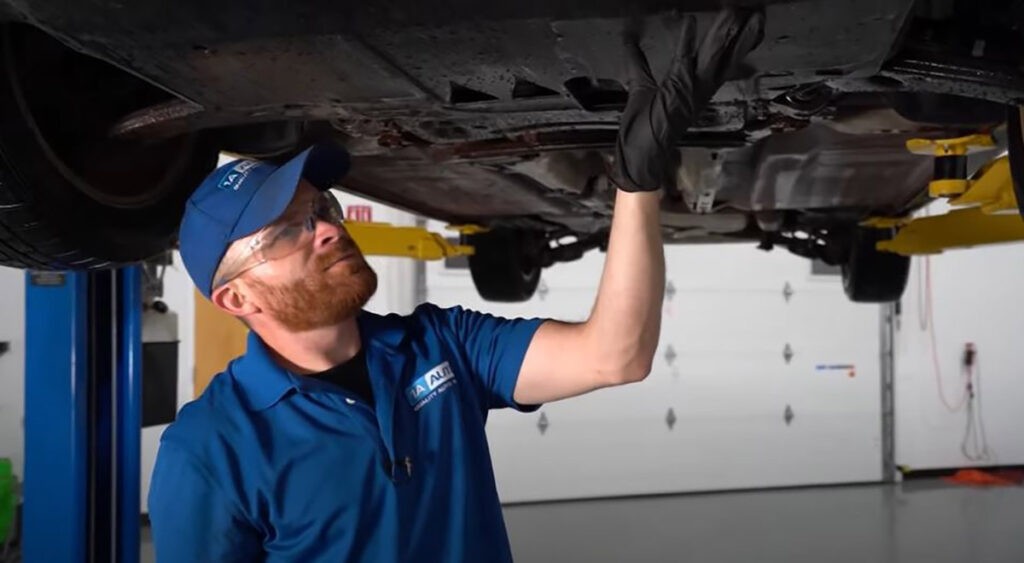That unsettling scraping sound while you’re driving could signal a problem with an under part of your car dragging on the road. Often, this culprit is the engine splash shield, a component designed to protect your engine compartment. Ignoring this issue can lead to further damage and unnecessary repair costs. This guide will help you understand how to identify if your splash shield is dragging, assess the damage, and perform a DIY fix to silence that irritating noise.
Understanding the Dragging Under Part: The Splash Shield
Alt text: Mechanic pointing to a car’s undercarriage, explaining a dragging splash shield as a cause of scraping noises.
The splash shield, sometimes called an engine splash guard or under engine cover, is typically a plastic or metal panel located beneath the engine compartment. Its primary function is to shield the engine area from road debris, water, and other contaminants. This protection is crucial because moisture and road grime can damage sensitive electronic components and other vital parts within the engine bay.
While some components, like a car battery with properly secured caps, might withstand some exposure, critical parts such as the engine control unit (ECU) or fuse box are vulnerable to moisture damage. Such damage can trigger a cascade of problems, affecting various vehicle systems.
Beyond protection, many modern vehicles utilize plastic splash shields as part of their aerodynamic design. A damaged or dragging shield disrupts airflow under the car. This disruption can negatively impact fuel efficiency as the intended aerodynamic profile is compromised, leading to increased drag.
For vehicles designed for tougher conditions, such as 4-wheel drive trucks intended for off-road use, manufacturers often install metal splash shields. These robust shields offer enhanced protection against larger, more damaging debris like rocks and branches encountered during off-road driving.
Splash Shield Replacement Costs: Is it Worth DIY?
A broken splash shield can manifest in several ways: improper bolting, cracks causing it to hang low, holes or missing sections, or detached fasteners leading to dragging. If the damage exceeds minor cracks or easily replaceable fasteners, a complete splash shield replacement becomes necessary.
Professional splash shield replacement at a repair shop can cost a couple of hundred dollars. However, you can significantly reduce this expense by purchasing a new or used splash shield and undertaking the replacement yourself. Numerous online retailers and auto parts stores offer splash shields at competitive prices, making DIY replacement a cost-effective option.
Driving with a Dragging Under Part: Is it Safe?
Operating your vehicle with a dragging engine splash shield is not advisable for several reasons. Firstly, it elevates the risk of moisture and debris accumulation within the engine compartment, potentially damaging critical components. Secondly, it can decrease your car’s fuel economy due to altered aerodynamics. Lastly, the constant scraping noise itself is a clear indicator of a problem and can be incredibly irritating. If you notice your Under Part Of Car Dragging, prompt action is recommended to prevent further issues.
DIY Splash Shield Repair: Silencing the Scraping Noise
For a split or hanging splash shield where the damage is not extensive, a DIY repair can often be effective. While tape or glue might offer temporary fixes, a more durable solution involves using a drill and wire ties (zip ties). This method provides a robust and lasting repair for cracked splash shields.
Steps to Repair a Dragging Engine Splash Shield:
-
Safety First: Raise and Secure Your Vehicle, Inspect the Damage
Before starting any repairs, ensure your car is safely raised and supported using jack stands. This provides safe access to the undercarriage. Carefully inspect the splash shield to assess the extent of the damage. If there are large holes or significant portions missing, replacement might be the only option. However, if the damage is primarily cracks, a repair is feasible. -
Drill and Secure with Wire Ties
Using a drill equipped with a small drill bit, carefully drill small holes on either side of the crack along its length. These holes will be used to thread the wire ties. Insert wire ties through the drilled holes and firmly tighten them to pull the cracked sections together. The number of wire ties needed will depend on the crack’s length and severity. Use enough ties to ensure a secure and robust repair. -
Verify the Seal
After tightening the wire ties, thoroughly inspect the repaired crack. Ensure the crack is now tightly sealed, effectively preventing moisture and debris from entering the engine compartment. A well-sealed repair is crucial for protecting your engine components from road elements.
Conclusion: Address that Dragging Under Part
A dragging under part of your car, often the splash shield, is more than just an annoying noise. It signals potential risks to your vehicle’s engine components and aerodynamic efficiency. By understanding the function of the splash shield, recognizing the signs of damage, and knowing how to perform a simple DIY repair, you can effectively address this issue. Whether you choose to replace the shield entirely or opt for a repair with wire ties, addressing a dragging under part promptly will protect your car and restore a quieter, more efficient driving experience.
